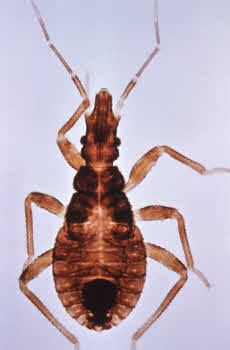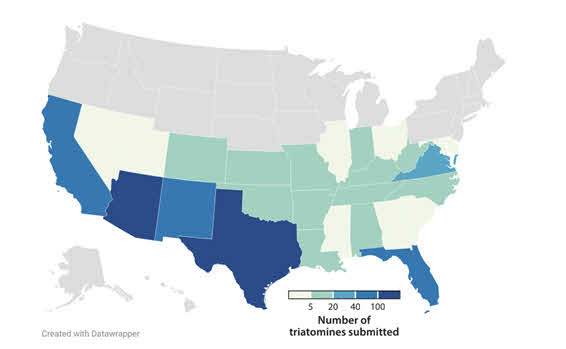Chagas disease is an infectious disease caused by a microscopic parasite called Trypanosoma cruzi. This parasite cannot infect mammals on its own and instead is spread by an insect called the kissing bug, or, more formally, the triatomine. Kissing bugs spread the parasites through their feces. If the bug bites a dog and then defecates nearby, parasites can infect the dog through the open wound from the bite. Dogs can also be infected by eating kissing bugs, as the parasites enter the body through mucous membranes like the gums.
Kissing bug Triatoma

Photo courtesy of CDC and WHO
Once the parasite infects an animal, if it is not treated promptly, it can reproduce and live in the body for the rest of the animal's life. Chagas has been a serious problem in humans and dogs in South America for many years, but recently there have also been cases reported in the southern United States.
Signs of Infection
Chagas has three stages after the animal has been infected: acute, latent, and chronic.
Acute Phase
During the acute phase, the parasite enters the dog's body and begins to infect macrophages, a type of white blood cell. Macrophages normally travel all through the body to fight infection and the parasite, hidden inside these cells, can move about undetected. When it reaches the heart, it begins to multiply and damage heart cells. The parasite can also infect many other body systems, including the nervous system, liver, kidneys, spleen, or lymph nodes.
Most animals only have mild symptoms at this stage, such as slight fever or low energy, although dogs younger than six months are more likely to be severely affected. This stage generally lasts for several weeks and throughout this time, there are many parasites in the blood and tissues. Unfortunately, due to the lack of visible symptoms, acute phase infections of Chagas are often missed. As a patient's immune system begins to fight the parasites, the number of parasites in the body goes down and the patient moves into the next phase of infection.
Latent Phase
During the latent phase, there are few parasites in the blood and the patient has no symptoms of illness. The immune system is generally not able to fully eliminate all the parasites in the body, but it keeps levels low enough that the patient doesn't feel sick. A Chagas infection at this stage is difficult to identify through laboratory testing because there are so few parasites in the blood. Some dogs may remain in the latent phase for the rest of their lives and will thus continue on without any symptoms.
Chronic Phase
Other dogs, however, will go on to the chronic phase of infection. We are not yet sure what triggers the chronic phase in some animals, but if the immune system becomes compromised through other diseases or injury, it can allow parasites to replicate again. As the immune system tries to fight against the growing number of parasites, it causes inflammation throughout the body, which can make the dog feel even sicker. Along with signs of systemic infection, like fever and lethargy, we also see symptoms of heart disease such as weakness, collapse, and, in severe cases, sudden death.
Diagnosis
Because Chagas disease is still relatively unknown in the United States, many cases are missed even after symptoms set in. Ask yourself the following questions to see if your pet is likely to have contracted Chagas:
- Do they currently live or have they ever lived in areas where Chagas disease is common? Infections are widespread in Texas, Oklahoma, Louisiana, Georgia, and Tennessee, but have been reported all through the southern United States.
- Does your dog have symptoms of heart disease, such as lethargy, weakness, collapse, or labored breathing? Or do they have symptoms of systemic disease, like fever or loss of appetite?
- Does your dog spend a lot of time outdoors, such as in a kennel, dog house, or as a working dog? Kissing bugs do not commonly live inside homes in the United States, but they can be found outside.
If your dog fits any of the above criteria and your veterinarian suspects Chagas, they may take a blood sample to send to a laboratory for molecular tests or to look at under a microscope. They may also take X-rays or use ultrasound to look at your dog's heart.
Triatomines of 11 species occur across the southern United States [map].

Busselman R. (2022) Figure 3: Triatomines of 11 species occur across the southern United States [map]. In Busselman R. Chagas Disease Ecology in the United States: Recent Advances in Understanding Trypanosoma cruzi Transmission Among Triatomines, Wildlife, and Domestic Animals and a Quantitative Synthesis of Vector-Host Interactions. Annual review of animal biosciences 10, 325–348.
Treatment
Drugs are available to fight the parasite infection and are quite effective during the acute phase. However, once the dog is in the chronic stage, it is no longer effective to only kill the parasites. Instead, the focus is on managing the symptoms of heart disease. Your veterinarian may recommend heart medications, prescription diets, or changes in exercise level.
Chagas Disease In Other Species
Although Chagas is also a serious condition in humans, your risk of contracting it from your dog is extremely low. You cannot get Chagas by being bitten or licked by an infected dog. The main risk to humans from dogs is for those who are handling infected blood samples, such as veterinary or laboratory staff.
Chagas has been seen in both domestic cats and wild cats, such as bobcats. However, it appears to be less common in cats than it is in dogs. Research on the disease in cats is minimal, but if your cat is showing symptoms of heart disease, promptly inform your veterinarian.
Prevention
Research is being done on a canine vaccine for Chagas, but as of right now, it is not commercially available. Even if it were available, it only provides partial protection. If you live in an area where Chagas has been reported, you can take the following steps to protect your pets:
- Do not allow your pets to interact with or eat meat from other species that might be infected (raccoons, opossums, armadillos, rodents and skunks). Your dog can contract Chagas by ingesting kissing bugs that are on these other animals.
- Regularly spray outdoor kennels and spaces with pyrethrin/permethrin insecticides, which are effective against kissing bugs.
- Before breeding female dogs, screen them for Chagas because it can be passed down to offspring.
Note that pyrethrin insecticides are toxic to cats in high doses. Spray insecticides are 1-5% pyrethrin, while most cats have symptoms of poisoning at concentrations around 40%, so pyrethrin sprays intended to be used outside are generally safe even if you have cats. Be sure to check the concentration of pyrethrin in the product you are using, store the container where cats can't access it and allow insecticides to dry fully before allowing cats to enter that space. Never apply a pyrethrin product directly to a cat.
Being informed of the risk factors and symptoms of Chagas disease is the best way to ensure that your pets receive timely care. The earlier you catch the infection, the better your chances of reducing long-term complications.